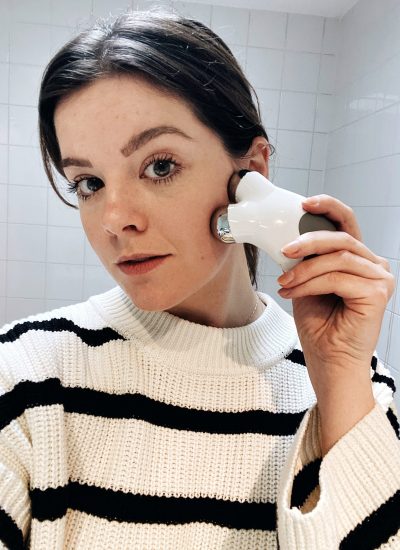
June is National Migraine and Headache Awareness Month to raise awareness and lower the stigma around headache disorders. I started talking more openly about my migraines on social media in the past year and have heard from so many who also suffer from migraines. 1 in 5 women and 1 in 15 men are affected by migraines, meaning at least one person you know probably deals with them. It made me want to share my migraine story.
For those of you who have never had a migraine or don’t know anyone who gets migraines, they’re so much more than a bad headache. According to the Cleveland Clinic, migraines are a “neurological disease [that] can cause debilitating throbbing pain that can leave you in bed for days. Movement, light, sound and other triggers may cause symptoms like pain, tiredness, nausea, visual disturbances, numbness and tingling, irritability, difficulty speaking, temporary loss of vision and many more.”
Migraines vary in strength and symptoms. For some, there is an aura that appears in their vision before the pounding headache on one side of their head. For others, migraines appear with no warning at all. Migraines can also show up with just the aura and no headache. Unfortunately, the cause of migraines is still unknown, which means it’s very difficult to treat migraines. There is no cure, but there are many different treatments that can lessen the frequency, strength, or effects of migraines.
My migraine story starts when I had my first migraine around age 10. At that age, it was by far the most pain I had ever experienced. It was a stabbing pain as if someone was continually driving a knife into my brain behind my eye for hours. The pain came with light and sound sensitivity that left me hiding under the covers with a damp towel.
I continued to have migraines for several years in my preteens. They would come on suddenly and unexpectedly. Often this would mean having to leave figure skating practice at a moments notice or having to be picked up from school. There was no predicting when or how they would come on. My parents took me to neurologists and I tried every treatment imaginable. I had MRIs and even tried anti-seizure medication. Eventually, my migraines started to grow less frequent on their own.
Throughout my teens, I had migraines ever few months or so. They were frustrating and painful, but thankfully manageable. For the most part, I could live my life normally.
In my early 20s, as I was finishing college after retiring from competitive figure skating, the migraines came back with a vengeance. The event that kicked it off was a migraine that lasted for several days. I was under my covers and in pain for about 48 hours before I took myself to the ER. There I received what they called the “migraine cocktail” via IV. This knocked me out for a few hours and kicked the migraine.
Following this, I started having much more frequent migraines. They ranged in symptoms, and I took myself to the ER one more time when I lost feeling in my left hand during an episode. The neurologist did another MRI and started me on some blood pressure medication to try and prevent my migraines. I was also given a medication to take at the onset of my migraine which would help lessen the headache. Unfortunately the preventative medication did nothing and the medication taken at onset made me feel like I had the flu, which was only marginally better than the headache pain.
It was when I started work at an advertising agency in NYC that I decided I had to try something different. My migraines would show up randomly in the middle of a meeting or ten minutes after I arrived in the office, making it hard for me to do my job well. I had recently heard about Botox for chronic migraines and decided I would see if I was a candidate.
Thankfully since my migraines were chronic and I had tried just about every other treatment, I was able to start Botox. Botox for migraines is a series of many shots throughout the forehead, temples, back of the head, neck, and shoulders. It’s intense, but the shots aren’t terribly painful and the procedure is done within 15 minutes.
My first three months after the initial Botox injections, I already started to notice a decline in the number of migraines I was having. And within six more months they were happening only once or twice between treatments. This dramatically improved my quality of life. My biggest fear growing up was that I would have a migraine pop up before an important event like my wedding. Now I feel confident I won’t miss big life events due to my migraines.
My migraine triggers are so varied, which makes it hard to predict when I will get them. After so many years of dealing with them, I have an idea of what will bring them on. Usually when I come down from a long period of stress, I will get a migraine. I also get them if I’ve had several days of poor or interrupted sleep. Big diet changes (like the one juice cleanse I tried) usually cause them. Bright lights, dehydration, and changes in the weather can also do it.
Thankfully since the Botox, I get migraines much less frequently. They’re also much less intense. I can often close my eyes for 45 minutes while the aura passes and return to work with just a minor headache.
Of course, this is my migraine story and not always going to be the case for other migraine sufferers. If you suffer from migraines, especially chronically, it’s absolutely worth talking to your doctor. There’s a stigma around migraines that they’re just headaches or not real, since others can’t visibly see the symptoms. And since there’s no cure, many people go without exploring some kind of treatment beyond taking ibuprofen. Migraines are a neurological disorder and deserve treatment and continued research into their cause.
If you know someone who suffers from migraines, give them grace. Their sudden onset and intense pain can make it difficult to keep plans or work normally.
If you’d like to learn more about migraines or Migraine and Headache Awareness Month, here are some resources:









